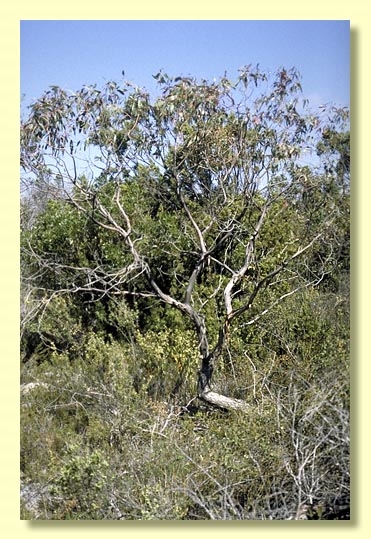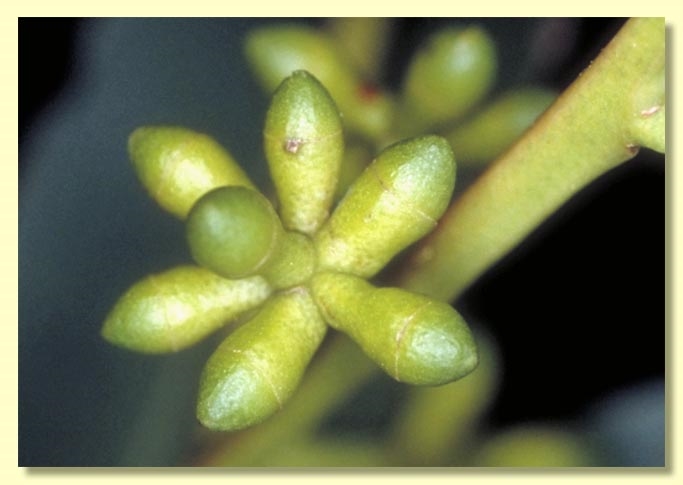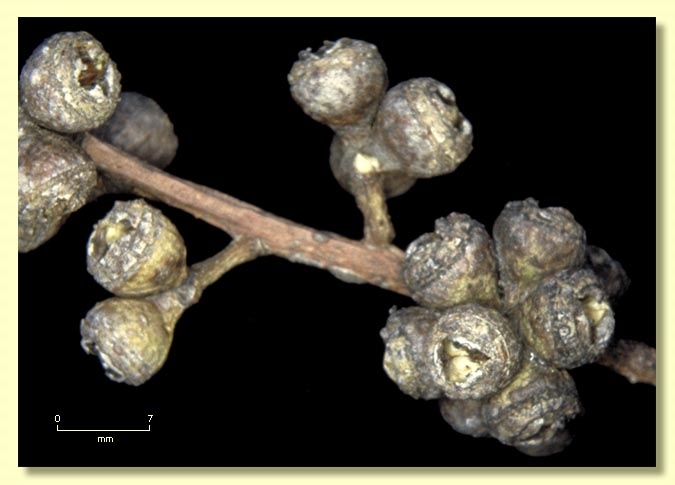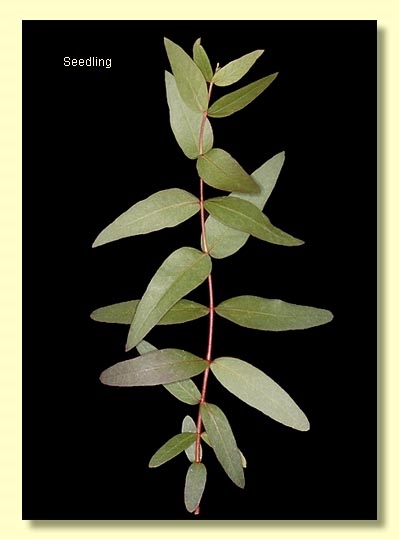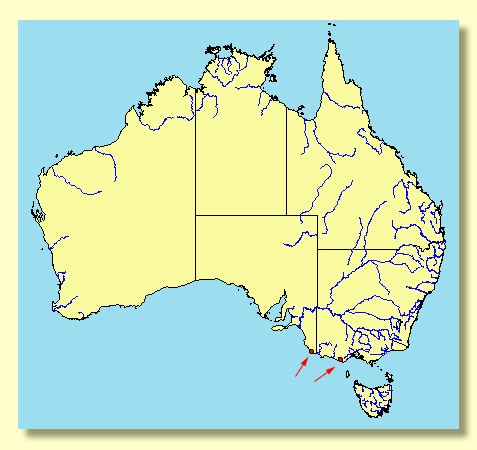Eucalyptus | Symphyomyrtus | Maidenaria | Euryotae | Viminales | Lanceolatae
Euclid - Online edition
Eucalyptus splendens subsp. arcana
Eucalyptus splendens subsp. arcana D.Nicolle & Brooker, J. Adelaide Bot. Gard. 18 (2) 103 (1998).
Eucalyptus arcana (D.Nicolle & Brooker) Rule, Muelleria 27: 230 (2009). T: South Australia: South-eastern region: east of Carpenter Rocks township, 26 Feb. 1997, D.Nicolle 1992 [but see note below]; holo: AD; iso: BRI, CANB, HO, K, MEL, NSW.
Note about type specimen: Nicolle & Brooker originally cited specimen D. Nicolle 1978 as the type specimen in error. The correct collector number on the type specimen is D. Nicolle 1992. All other collection details originally published were correct. This error was repeated by Rule (2009). The error was corrected in the book D. Nicolle (2013) "Native Eucalypts of South Australia" p. 152.
Straggly tree to 4 m tall. Forming a lignotuber.
Bark rough, grey and grey-brown, thin, fibrous, shallowly fissured down trunk, breaking into short strips, quite tessellated on older trunks.
Juvenile growth (coppice or field seedlings to 50 cm): stem square in cross-section on lower growth; juvenile leaves opposite for ca 14 to 23 pairs, becoming alternate (may then revert to opposite for several nodes), very shortly petiolate, elliptical to ovate, 4.5–12 cm long, 1.3–5.5 cm wide, base tapering to petiole or rounded, margin usually entire, rarely crenulate, glossy, green.
Adult leaves alternate, petiolate, 1–2.8 cm long; blade lanceolate to falcate, 8–15 cm long1.7–3 cm wide, base tapering to petiole, margin entire, concolorous, glossy, green, side-veins at an acute or wider angle to midrib, densely reticulate, intramarginal vein parallel to and well removed from margin, oil glands sparse, island and intersectional.
Inflorescence axillary single, peduncles 0.4–1 cm long, buds 7 per umbel, pedicels 0–0.2 cm long. Mature buds fusiform to obovoid, 0.5–0.6 cm long, 0.4 cm wide, smooth, scar present, operculum bluntly conical, stamens mostly inflexed with some irregularly flexed, all fertile, anthers cuboid, versatile, sub-basifixed, dehiscing by longitudinal slits (non-confluent), style long, stigma blunt or more or less pin-head, locules 3 or 4, with 4 vertical ovule rows on the placenta.
Fruit usually sessile (rarely only 0.1 cm long), hemispherical or cup-shaped, 0.4–0.6 cm long, 0.5–0.8 cm wide, disc raised, valves 3 or 4, exserted or near rim level.
Seeds black, grey or brown, 1.5–3 mm long, ovoid or flattened-ovoid or pointed at one end, usually lacunose, dorsal surface shallowly pitted, hilum ventral.
Cultivated seedlings (measured at ca node 10): cotyledons bilobed to oblong; stems square in cross-section for at least 18 nodes, warty; leaves sessile and opposite for at least 18-24 nodes, ovate to lanceolate, 4.7–10.5 cm long, (1.3)1.8–3.2 cm wide, base rounded, never stem-clasping, green.
Flowering has been recorded in January and February.
Eucalyptus splendens (with two subspecies) is a small to medium-sized rough-barked tree so far known from three scattered localities viz. Moonlight Head and near Mt Richmond in coastal western Victoria, and near Carpenter Rocks on the coast of South Australia, west of Mt Gambier. It is completely rough-barked, has glossy green adult leaves, bright glossy green juvenile leaves that remain sessile and opposite for many nodes and are not stem-clasping but taper basally; seedling and juvenile stems in E. splendens are square in cross-section.
There are two subspecies:
E. splendens subsp. splendens
An erect tree to 10 m tall with lanceolate juvenile leaves to 9 cm long and 2.5 cm wide, and acutely conical buds. Adult leaves are 10-25 cm long. It is confined to the Mount Richmond locality.
E. splendens subsp. arcana
A small straggly tree to ca 4 m tall, with ovate to ovate-lanceolate juvenile leaves to 12 cm long and 5.5 cm wide, and buds that are bluntly conical compared with subsp. splendens. Adult leaves are 8-15 cm long. It is known from the vicinity of Carpenter Rocks in South Australia and at Moonlight Head in Victoria.
Eucalyptus splendens has somewhat obscure affinities and has been allied to both the E. viminalis and the E. aromaphloia groups of species in the past. It differs from E. viminalis because the juvenile leaves are not stem-clasping (always stem-clasping in E. viminalis, never stem-clasping in E. aromaphloia), and it differs from E. aromaphloia in having juvenile stems squared in cross-section (always rounded in E. aromaphloia, rounded to more or less squared in E. viminalis). All three species have basically similar bud, fruit and seed features, though number of buds per umbel and dimensions may differ.
In the classification of Brooker (2000) Eucalyptus splendens is placed in Eucalyptus subgenus Symphyomyrtus section Maidenaria, a large group of species more or less restricted to south-eastern Australia, characterised by bilobed cotyledons, simple axillary inflorescences, buds with two opercula the outer of which sheds early in bud development, stamens with versatile anthers and flattened seeds with a ventral hilum. Within this section, Brooker places E. splendens in series Viminales subseries Lanceolatae, having buds in sevens, fruit with an ascending disc and exserted valves, and green, sessile, lanceolate juvenile leaves opposite for many pairs, and this is followed in EUCLID. E. splendens differs most notably from other species in series Viminales by the tapering (not stem-clasping) leaf-bases of the juvenile leaves and the conspicuously squared juvenile stems. Nicolle (2006) stated that the taxonomic relationship of E. splendens is with series Acaciiformes which also includes E. aromaphloia, while Rule (1996) also suggested that its affinity is with E. aromaphloia.
Plants at Moonlight Head in Victoria are regarded by Nicolle (2006) as being subsp. arcana but are considered by other botanists (e.g. Chappill et al (1986) and Rule (2009)) to be close to E. aromaphloia (subsp. aromaphloia). Eucalyptus splendens subsp. arcana (from Carpenter Rocks) is regarded by Rule (ibid.) as a species (i.e. Eucalyptus arcana ).
subsp. arcana: Latin arcana, secret, mysterious, referring to the unexpected discovery of the subspecies.

